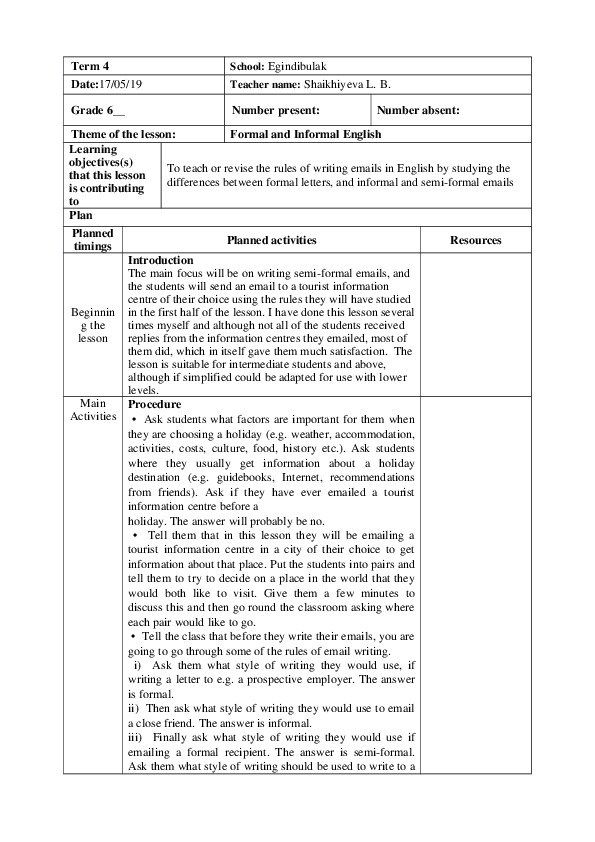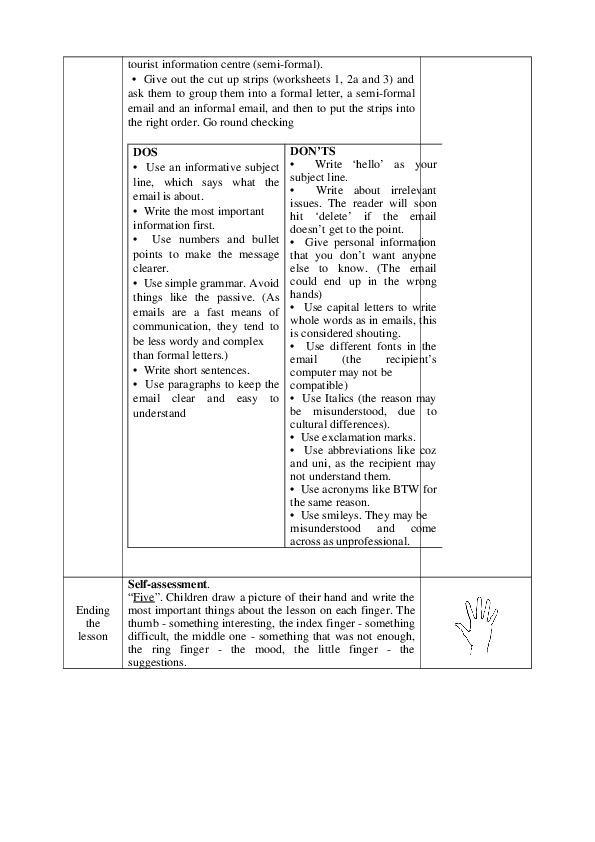School: Egindibulak
Teacher name: Shaikhiyeva L. B.
Number present:
Number absent:
Formal and Informal English
To teach or revise the rules of writing emails in English by studying the
differences between formal letters, and informal and semiformal emails
Planned activities
Resources
Term 4
Date:17/05/19
Grade 6__
Theme of the lesson:
Learning
objectives(s)
that this lesson
is contributing
to
Plan
Planned
timings
Beginnin
g the
lesson
Main
Activities
Introduction
The main focus will be on writing semiformal emails, and
the students will send an email to a tourist information
centre of their choice using the rules they will have studied
in the first half of the lesson. I have done this lesson several
times myself and although not all of the students received
replies from the information centres they emailed, most of
them did, which in itself gave them much satisfaction. The
lesson is suitable for intermediate students and above,
although if simplified could be adapted for use with lower
levels.
Procedure
• Ask students what factors are important for them when
they are choosing a holiday (e.g. weather, accommodation,
activities, costs, culture, food, history etc.). Ask students
where they usually get information about a holiday
destination (e.g. guidebooks, Internet, recommendations
from friends). Ask if they have ever emailed a tourist
information centre before a
holiday. The answer will probably be no.
• Tell them that in this lesson they will be emailing a
tourist information centre in a city of their choice to get
information about that place. Put the students into pairs and
tell them to try to decide on a place in the world that they
would both like to visit. Give them a few minutes to
discuss this and then go round the classroom asking where
each pair would like to go.
• Tell the class that before they write their emails, you are
going to go through some of the rules of email writing.
i) Ask them what style of writing they would use, if
writing a letter to e.g. a prospective employer. The answer
is formal.
ii) Then ask what style of writing they would use to email
a close friend. The answer is informal.
iii) Finally ask what style of writing they would use if
emailing a formal recipient. The answer is semiformal.
Ask them what style of writing should be used to write to atourist information centre (semiformal).
• Give out the cut up strips (worksheets 1, 2a and 3) and
ask them to group them into a formal letter, a semiformal
email and an informal email, and then to put the strips into
the right order. Go round checking
DOS
• Use an informative subject
line, which says what the
email is about.
• Write the most important
information first.
• Use numbers and bullet
points to make the message
clearer.
• Use simple grammar. Avoid
things like the passive. (As
emails are a fast means of
communication, they tend to
be less wordy and complex
than formal letters.)
• Write short sentences.
• Use paragraphs to keep the
email clear and easy to
understand
Write ‘hello’ as your
DON’TS
•
subject line.
•
Write about irrelevant
issues. The reader will soon
hit ‘delete’ if the email
doesn’t get to the point.
• Give personal information
that you don’t want anyone
else to know. (The email
could end up in the wrong
hands)
• Use capital letters to write
whole words as in emails, this
is considered shouting.
• Use different fonts in the
email
recipient’s
computer may not be
compatible)
• Use Italics (the reason may
be misunderstood, due to
cultural differences).
• Use exclamation marks.
• Use abbreviations like coz
and uni, as the recipient may
not understand them.
• Use acronyms like BTW for
the same reason.
• Use smileys. They may be
misunderstood and come
across as unprofessional.
(the
Selfassessment.
“Five”. Children draw a picture of their hand and write the
most important things about the lesson on each finger. The
thumb something interesting, the index finger something
difficult, the middle one something that was not enough,
the ring finger the mood, the little finger the
suggestions.
Ending
the
lesson


